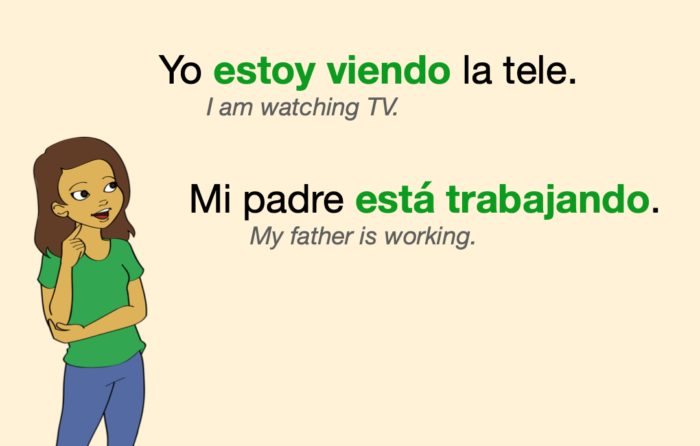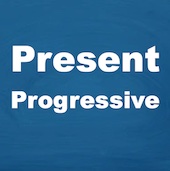Welcome 😊 to our grammar lesson on the Spanish Present Progressive (“Presente Progresivo” or “Presente Continuo”).
We use the Present Progressive to express what’s happening now, at the moment.
It is equivalent to the English “I am eating… she is drinking… we are driving, etc”.

By the end of this lesson, you will be able to conjugate verbs in Present Progressive and use them in sentences.
You will also find a Quiz and Exercises to practice.
Contents
Conjugation of verbs in Present Progressive
The formula to form the Present Progressive consists of 2 words:
- First, the verb estar in Present Tense: estoy, estás, está, estamos, estáis, están.
- Second, the Gerundio of the verb expressing the action. The Gerundio is the same for all persons.
Using that formula, here is a table with three verbs fully conjugated in Present Progressive. These particular verbs have a regular Gerundio:
to speak to drink to depart
Person hablar
beber partir
yo estoy hablando estoy bebiendo estoy partiendo
tú estás hablando estás bebiendo estás partiendo
él está hablando está bebiendo está partiendo
nosotros estamos hablando estamos bebiendo estamos partiendo
vosotros estáis hablando estáis bebiendo estáis partiendo
ellos están hablando están bebiendo están partiendo
And here are a couple more verbs conjugated in Present Progressive. These are verbs with an irregular Gerundio:
| Person | dormir to sleep | leer to read |
|---|---|---|
| yo | estoy durmiendo | estoy leyendo |
| tú | estás durmiendo | estás leyendo |
| él | está durmiendo | está leyendo |
| nosotros | estamos durmiendo | estamos leyendo |
| vosotros | estáis durmiendo | estáis leyendo |
| ellos | están durmiendo | están leyendo |
Remember…
The Gerundio of regular verbs in -ar ends in -ando.
The Gerundio of regular verbs in -er and -ir ends in -iendo.
Some verbs have an irregular Gerundio. The most important irregular ones are:
decir → diciendo
dormir → durmiendo
morir → muriendo
pedir → pidiendo
venir → viniendo
leer → leyendo
oír → oyendo
ir → yendo
Click here to learn all about the Gerundio, and more irregular Gerundios
Use of the Present Progressive
We use the Present Progressive to express what’s happening right now, at the moment. For example, what people are doing:
¿Qué estás haciendo?
What are you doing?Yo estoy estudiando para el examen.
I am studying for the exam.Nosotros estamos jugando al dominó.
We are playing dominoes.Mis padres no están en casa, están trabajando.
My parents are not home, they are working.Está lloviendo.
It is raining.Vosotros estáis leyendo un libro.
You guys are reading a book.
Placing the word “no”: always before the whole verb
To form a negative sentence, we place no before the two words that form the Present Progressive, never in between:
Vosotros no estáis durmiendo.
You guys are not sleeping.No está nevando.
It is not snowing.
Keywords with the Present Progressive
The following keywords work well in sentences with the Present Progressive:
- ahora = now
- ahora mismo = right now
- en este momento = at the moment
- actualmente = currently
Example sentences:
¿Estás trabajando ahora?
Are you working now?Ahora mismo estoy escuchando música.
Right now I am listening to music.Mis sobrinos están durmiendo en este momento.
My nephews are sleeping at the moment.Actualmente estamos desarrollando una nueva teoría.
We are currently developing a new theory.
Present Tense Vs. Present Progressive
We use these two tenses for different things:
- The Present Tense to talk about habitual actions and events, and also to state facts.
- The Present Progressive to talk about what is happening right now, at the moment.
For example, compare the following sentences:
María duerme ocho horas cada noche.
Maria sleeps eight hours a night. (Present Tense)María está durmiendo ahora.
María is sleeping now. (Present Progressive).
Practice
Quiz
Take this short Quiz about the Present Progressive:
Exercise 1
Conjugate the following verbs in Present Progressive. Click on the gray spaces to see the solutions.
(These verbs have regular Gerundios)
1) yo estoy nadando (nadar)
2) tú estás bebiendo (beber)
3) él está viviendo (vivir)
4) nosotros estamos saliendo (salir)
5) vosotros estáis entrando (entrar)
6) ellos están volviendo (volver)
Exercise 2
In the following sentences, fill the gaps using the Present Progressive of the verb in brackets.
(These verbs have regular Gerundios)
1) ¿Qué están haciendo tus amigos? (hacer)
What are your friends doing?
2) La niña está escuchando la radio. (escuchar)
The girl is listening to the radio.
3) Nosotros estamos jugando a las cartas. (jugar)
We are playing cards.
4) Vosotras estáis bailando. (bailar)
You girls are dancing.
5) Tú estás limpiando el dormitorio. (limpiar)
Yo are cleaning the bedroom.
6) Yo estoy entendiendo la lección. (entender)
I’m understanding the lesson.
Exercise 3
Conjugate the following verbs in Present Progressive.
(These verbs have irregular Gerundios)
1) yo estoy vistiendo (vestir)
2) tú estás trayendo (traer)
3) él está oyendo (oír)
4) nosotros estamos siguiendo (seguir)
5) vosotros estáis sintiendo (sentir)
6) ellos están yendo (ir)
Exercise 4
In the following sentences, fill the gaps using the Present Progressive of the verb in brackets.
(These verbs have irregular Gerundios)
1) La mujer está leyendo el periódico. (leer)
The woman is reading the newspaper.
2) Tú estás pidiendo una cerveza. (pedir)
You are ordering a beer.
3) Nosotros no estamos durmiendo. (dormir)
We are not sleeping.
4) ¿Vosotros estáis oyendo lo que yo estoy diciendo? (oír, decir)
Are you guys hearing what I’m saying?
5) Los camareros están sirviendo la comida. (servir)
The waiters are serving the food.









